
Blooms on their brightest day
“Built on trial, error, and small garden victories.”
The garden is part instinct, part experiment—a sun-soaked mix of drought-tolerant showstoppers, shade lovers, and the occasional uninvited bloomer that earns its place. I’m drawn to bold colors, wild textures, and anything that hums with pollinators or surprises me by thriving. I don’t follow strict rules—I follow what makes me smile. Roses, caladiums, passionfruit vines... if it brings joy or energy, it stays. The result is a garden that’s vibrant, low-maintenance, and a little bit rebellious—in all the best ways
-

Osteospermum 4D® (African Daisy)
These cheerful blooms open with the morning sun and close again at dusk — like they’re shy but still trying their best. Known for their bold purple centers and daisy-like petals, African Daisies are drought-tolerant and happiest in full sun. A reliable burst of color when the garden needs a little lift.
Ideal Zones: 9–11
Sun: Full sun (can tolerate part shade in hot climates)
Water: Moderate; let soil dry slightly between waterings
-
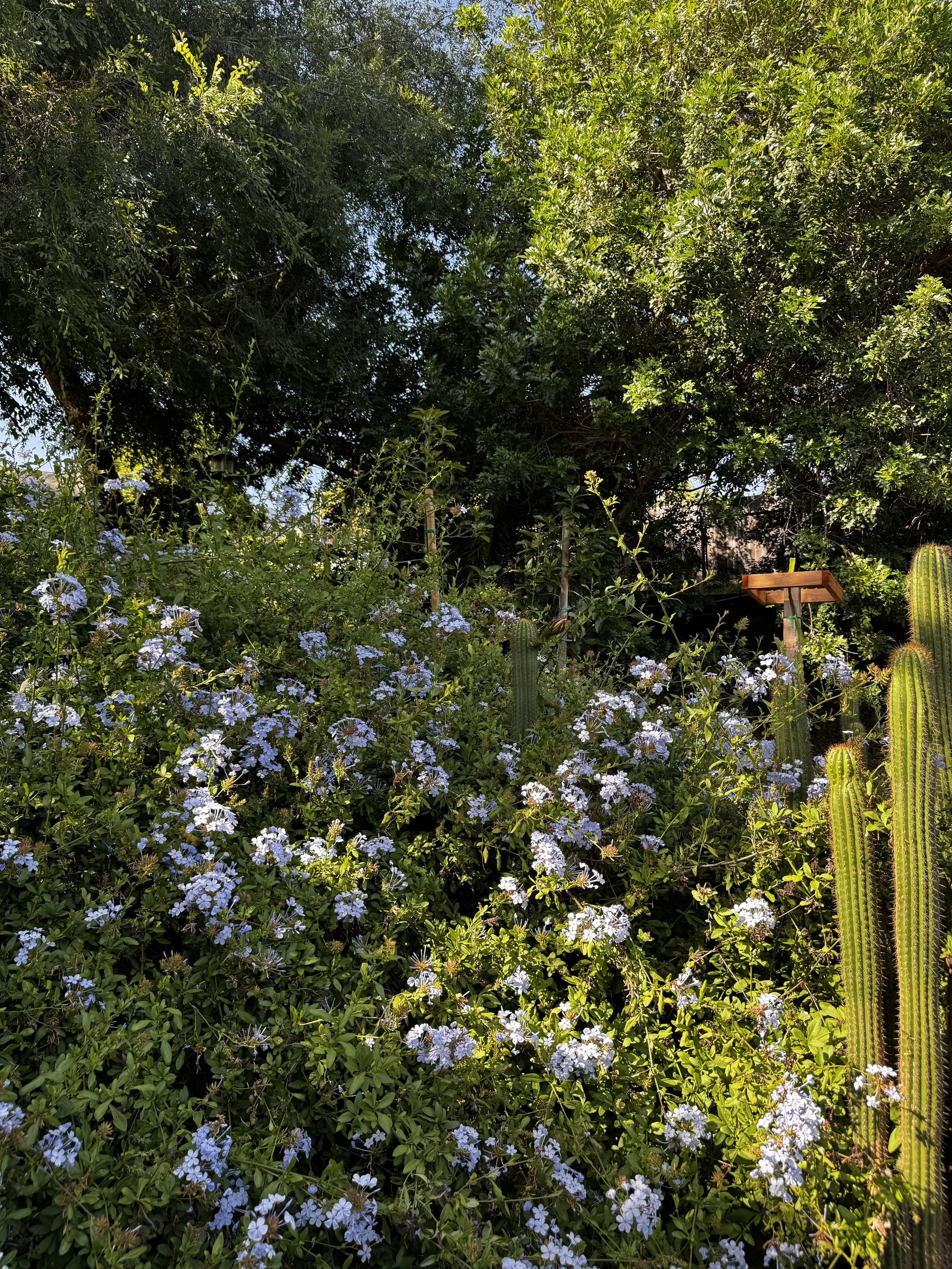
Cape Plumbago (Plumbago auriculata)
These pale blue blooms are everywhere—and we didn’t plant a single one. They came with the house and have made themselves right at home, thriving with zero watering and plenty of sun. Cape Plumbago is a carefree, fast-growing shrub that spills and climbs with ease, offering color, coverage, and a steady stream of butterflies without asking for much in return.
Ideal Zones: 9–11
Sun: Full sun to part shade
Water: Low to moderate once established
-

Martha Washington Geranium (Pelargonium × domesticum)
Ideal Zones: 9–10 (can be grown as annual or overwintered indoors in cooler zones)
Sun: Morning sun with afternoon shade or bright filtered light
Water: Keep soil evenly moist, especially during bloom season; avoid letting it dry out fully
-
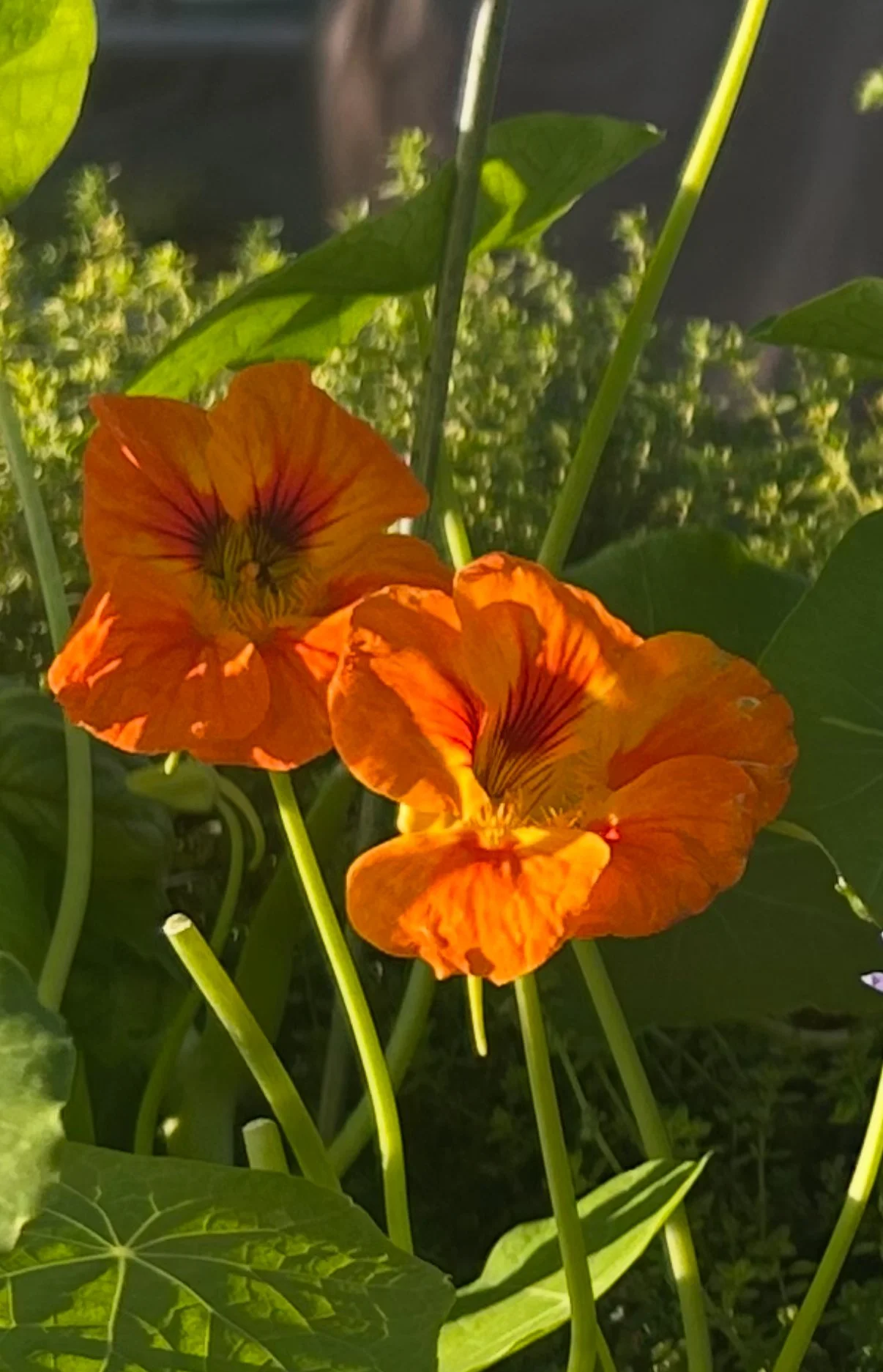
Nasturtium (Tropaeolum majus)
These cheerful, edible flowers glow in fiery shades of orange, red, and yellow, with lily pad–shaped leaves that spill out like a garden waterfall. Nasturtiums are easy to grow, quick to bloom, and completely edible—flowers, leaves, and even the seed pods. Bonus: they help repel garden pests while attracting pollinators.
Ideal Zones: 9–11 (grows as an annual elsewhere)
Sun: Full sun to part shade
Water: Low to moderate; prefers well-draining soil
-
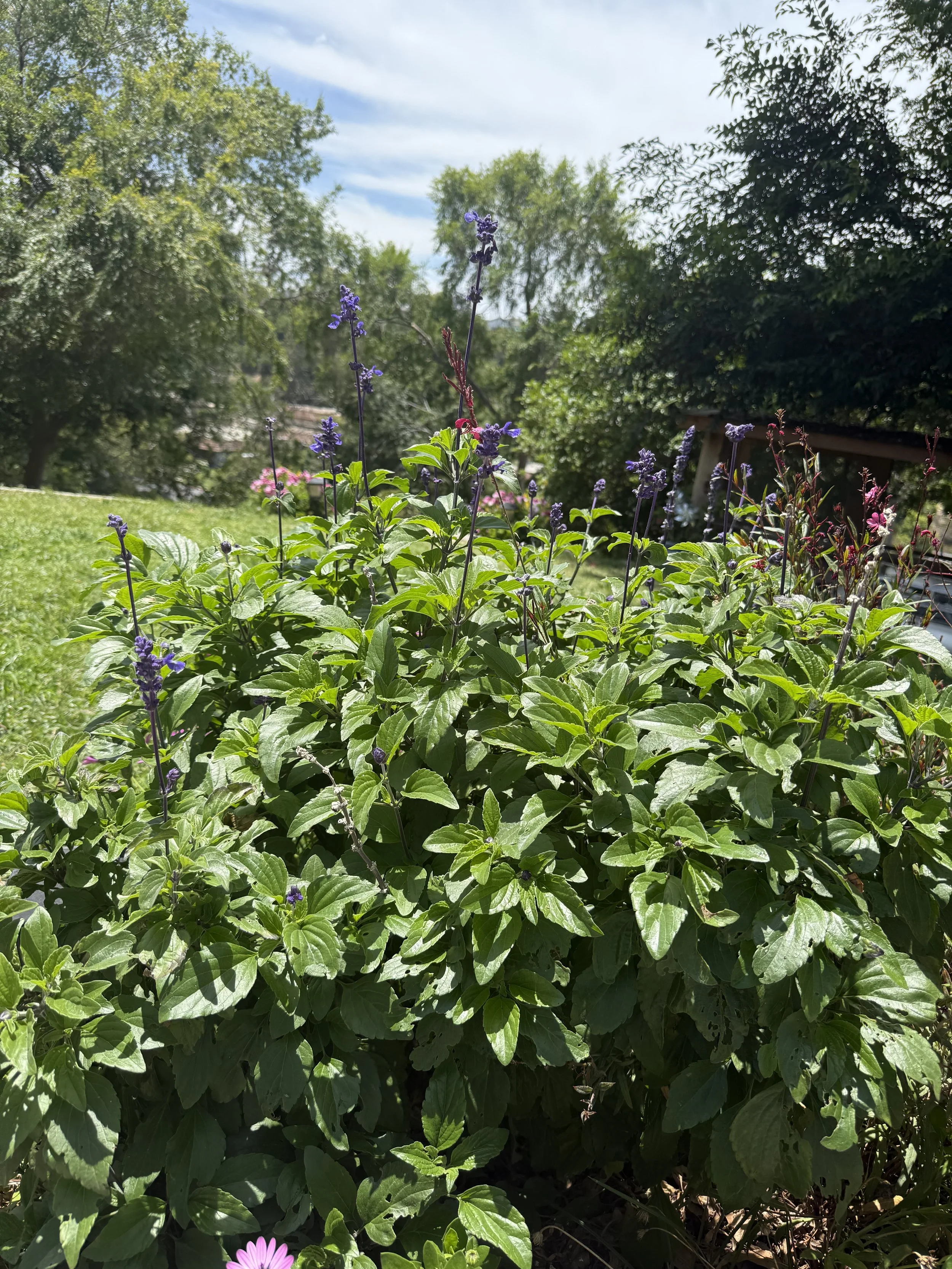
Victoria Blue Salvia (Salvia farinacea)
Tall, upright spikes of rich violet-blue rise above lush green foliage, making this salvia a standout in any sunny bed. Loved by bees, butterflies, and hummingbirds alike, it’s a reliable bloomer that brings color and movement to the garden from spring through fall.
We planted ours in full sun, and it’s been thriving with minimal fuss—just the occasional trim to encourage even more blooms. It’s one of those plants that quietly does a lot of work, feeding pollinators and adding structure without needing constant attention.
Ideal Zones: Perennial in Zones 8–10 (may act as an annual elsewhere)
Sun: Full sun
Water: Low to moderate; drought-tolerant once established
-

Plum Perfect (Rosa floribunda ‘KORvodacom’)
These richly colored blooms live up to their name—lush plum petals packed tightly in ruffled layers that unfold like velvet. They bring a burst of royal color to the garden and hold up beautifully through heat and repeat blooming. Plus, their mild fragrance and sturdy stems make them just as lovely in a vase as on the bush.
Ideal Zones: 5–10
Sun: Full Sun
Water: Regular watering; prefers well-draining soil
-

Gerbera Daisy (Gerbera jamesonii)
Like a smile in flower form. Gerbera Daisies bring big energy with their oversized blooms and neon colors. This variety is a favorite for cutting gardens, and the bees love them too. They’re bold, happy, and always reaching for the sun — just like we all hope to be.
Ideal Zones: 8–11 (perennial in warm zones, annual elsewhere)
Sun: Full sun to light afternoon shade
Water: Moderate; water when the top inch of soil feels dry, avoid overhead watering
-

Larkspur (Consolida ajacis)
This one showed up uninvited—and we’re not mad about it. Likely a hitchhiker from one of our wildflower seed mixes, this larkspur planted itself in a bare patch and decided to bloom like it belonged there. With feathery foliage and vivid purple-blue spires, it brings just enough wild charm to feel like a happy accident.
Ideal Zones: 6–10 (cool-season annual in warm zones)
Sun: Full sun to light shade
Water: Moderate; prefers moist, well-drained soil during growth
-

Pink Gaura (Oenothera lindheimeri (formerly Gaura lindheimeri)
Always dancing. Pink Gaura sends up clouds of delicate blossoms that flutter in the breeze like butterflies. This airy, graceful plant blooms for months, attracting bees and pollinators without ever asking for much in return. It thrives on neglect, prefers sun, and rewards you with nonstop movement and color — like garden confetti that never needs sweeping.
Ideal Zones: 5–10 (perennial in mild climates, may die back in frost)
Sun: Full sun (can tolerate part shade but blooms best in sun)
Water: Low to moderate; drought-tolerant once established
-

Crown of Thorns (Euphorbia milii)
A little tough, a little thorny — but always showing up with color. The Crown of Thorns pushes out bright, paper-like blooms even in heat and drought, making it a standout in any low-maintenance garden. It may have spines, but it’s all heart. This one’s for the survivors who still find a way to bloom.
Ideal Zones: 9–11 (perennial outdoors in warm climates; can be grown in pots elsewhere)
Sun: Full sun to partial shade (best bloom in full sun)
Water: Low; drought-tolerant once established. Allow soil to dry between waterings
-

Blanket Flower (Gaillardia × grandiflora)
Like little bonfires in the garden, these blooms bring heat and energy wherever they land. This variety’s vivid red and orange petals with golden tips make it a standout in any bed—especially against green or shady backdrops. It thrives in dry, sunny conditions and keeps blooming even when other flowers start to fade.
Ideal Zones: 3–10
Sun: Full sun
Water: Low; prefers dry, well-draining soil once established
-

Lady Barbara Hibiscus (Hibiscus 'Lady Barbara')
This hibiscus may bloom briefly, but she’s endlessly determined—sending up fresh buds even after the rabbits (or something sneakier) take a bite. Her soft lavender petals and bold crimson center feel both delicate and wild, standing out against the green with very little fuss. Despite the drama in her look, she’s low-maintenance and perfectly suited for warm, dry gardens.
Ideal Zones: 9–11
Sun: Full sun to light shade
Water: Moderate; drought-tolerant once established
-

Yellow Plant (Left): Scotch Broom (Cytisus scoparius)
A burst of golden blooms on slender green stems, Scotch Broom thrives in tough conditions and brings serious color with very little effort. Its arching shape and fine foliage make it a great backdrop or border shrub. Just be sure to give it space—it can grow fast and wide if happy.
Ideal Zones: 6–9
Sun: Full sun
Water: Low; drought-tolerant once established
-

Naked Ladies (Amaryllis belladonna)
These pale pink show-stoppers showed up out of nowhere—no leaves, no warning, just tall stalks topped with trumpet-shaped blooms. We didn’t even know we had them until they started randomly sprouting one summer.
Known as “Naked Ladies” for their leafless bloom display, they grow their foliage quietly in spring, go dormant, and then pop up later in the year like they’ve got their own secret schedule. No fuss, no maintenance—just a beautiful surprise every time.
Ideal Zone: Perennial in Zones 7–10
Sun: Full sun to part shade
Water: Low; drought-tolerant once established
-

Easy Does it Roses (Rosa floribunda ‘HARpageant’)
True to its name, Easy Does It™ delivers effortless beauty with a carefree attitude. The ruffled blooms shift between peach, apricot, and coral-pink, creating a sunset effect that glows in the garden. It’s a prolific bloomer with excellent disease resistance—ideal for beginners or anyone who just wants a rose that shows up and performs.
Ideal Zones: 5–10
Sun: Full sun
Water: Regular; prefers well-draining soil
-

Golden Opportunity (Rosa ‘Golden Opportunity’)
With large, golden-apricot blooms and a soft fruity fragrance, Golden Opportunity™ is a standout climber that adds vertical magic to any garden space. Its blooms are long-lasting and repeat generously through the warm months, making it a favorite for arbors, trellises, and fences. Easy to train and quick to impress, this rose truly lives up to its name.
Ideal Zones: 5-10
Sun: Full sun
Water: Regular; prefers well-draining soil
-

Kalanchoe (Kalanchoe blossfeldiana)
We have these scattered all over the yard in every shade—but this vibrant pink one in a tiny pot is hands-down our favorite. Kalanchoe is a flowering succulent that barely needs anything to thrive. It blooms in bold clusters, handles drought like a champ, and stays compact and cheerful wherever it’s planted. Low effort, high reward.
Ideal Zones: 9–11 (or grown as a houseplant elsewhere)
Sun: Bright indirect light to full sun
Water: Low; allow soil to dry between waterings
-

Anemone coronaria (Poppy Anemone)
Delicate, wind-kissed, and unexpectedly bold—these anemones bring a fresh pop of purple to the spring garden. Their dark centers and silky petals catch the morning light like watercolor. Low-maintenance and pollinator-friendly, they add movement and softness to beds and borders without ever trying too hard.
Ideal Zones: 7–10
Sun: Full sun to part shade
Water: Moderate; prefers well-draining soil
-

Frederick’s Passion Fruit (Passiflora edulis ‘Frederick’)
This vine is a total scene-stealer. With its wildly intricate purple and white blooms and lush tropical foliage, Frederick’s Passion Fruit adds instant drama to the garden—and rewards us with juicy, tangy-sweet fruit once it’s done showing off.
We planted it for the fruit, but the flowers alone would’ve been worth it. It’s climbing strong with support, and has quickly become a pollinator favorite. This variety is especially well-suited for Southern California’s climate and tends to be more productive and cold-tolerant than other passion fruits.
Ideal Zone: Perennial in Zones 9–11
Sun: Full sun
Water: Regular; prefers consistent moisture
-
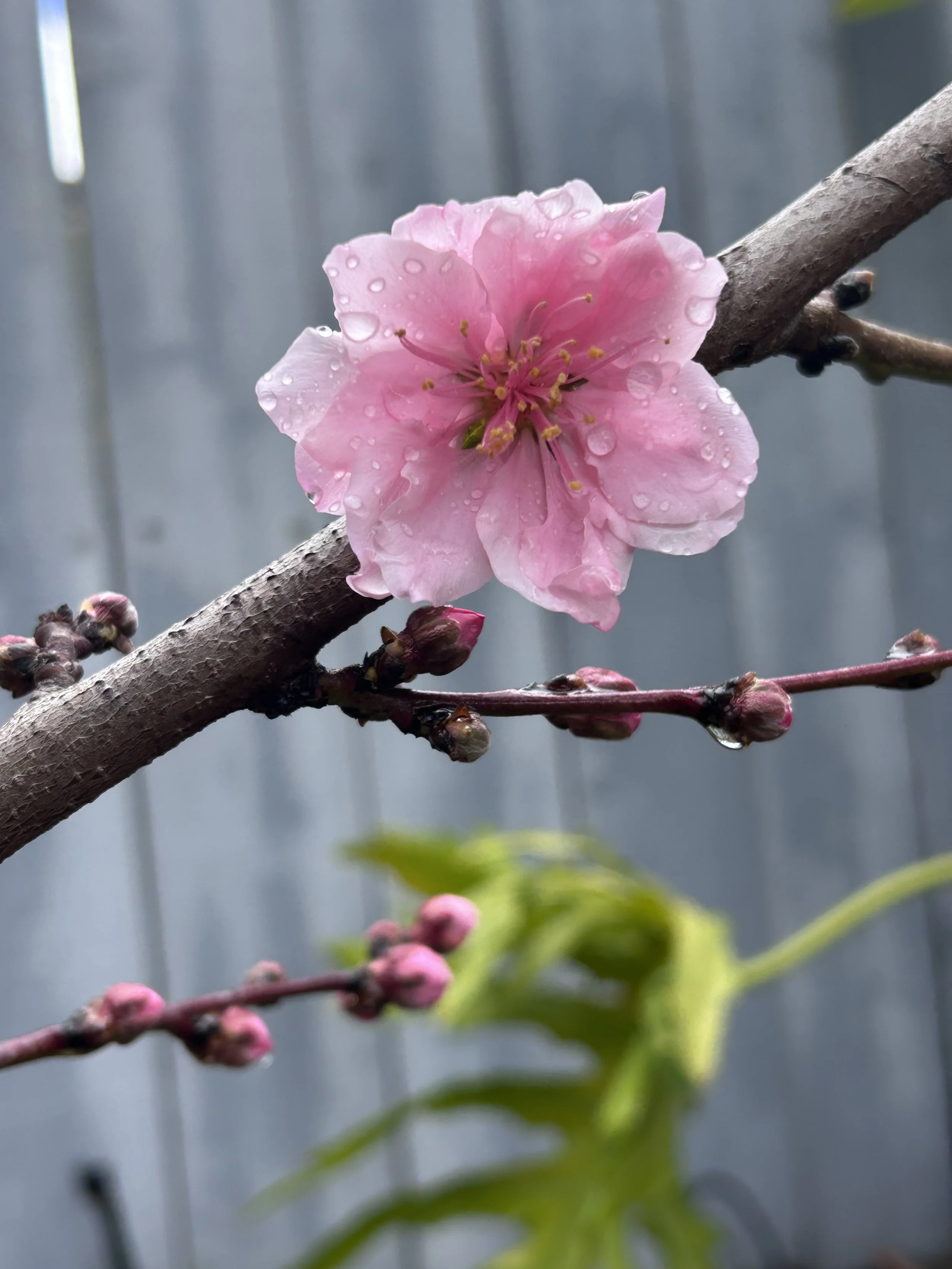
Double Delight Nectarine (Prunus persica var. nucipersica)
This tree puts on a show before the season even starts—bursting into fragrant pink blooms while the branches are still bare. It’s one of the few fruit trees that flowers before leafing out, making it a favorite for early spring beauty. As the blooms fade, lush leaves emerge and pave the way for sweet, richly flavored nectarines with smooth skin and a tropical twist.
Ideal Zones: 6–9
Sun: Full sun
Water: Regular; more during fruiting season
-

Pink/Purple Plant (Right): Regal Geranium – Pelargonium x domesticum
These velvety blooms come in bold, saturated shades with striking “painted” centers. Regal geraniums bring drama and charm to beds and containers alike, blooming heavily in spring and early summer. They're a little fussier than standard geraniums but worth every bit of extra care.
Ideal Zones: 9–11 (or grown as annuals elsewhere)
Sun: Morning sun, light afternoon shade
Water: Moderate; let soil dry slightly between waterings
-

Daylily (Hemerocallis hybrid)
These rich, velvety blooms pop open for just one day at a time—but when they do, they absolutely steal the show. Tucked into a mixed bed with partial sun and plenty of neighbors, this daylily still manages to hold its own. It’s hardy, low-maintenance, and comes back reliably each year, even if the leaves get a little wild by midsummer.
Ideal Zones: 4–10
Sun: Full sun to part shade
Water: Moderate; drought-tolerant once established
-

Bougainvillea (Bougainvillea spp.)
These bold, blooming giants bring instant tropical drama to the garden—and clearly, they don’t believe in holding back. With vivid fuchsia on one side and rich red on the other, this duo of bougainvilleas adds a wall of color that glows in full sun. Fast-growing, drought-tolerant, and a little wild, they thrive with minimal water and maximum light. Just give them space to shine—and maybe a pair of gloves when it’s pruning time.
Ideal Zones: 9–11
Sun: Full sun
Water: Low; very drought-tolerant once established
-
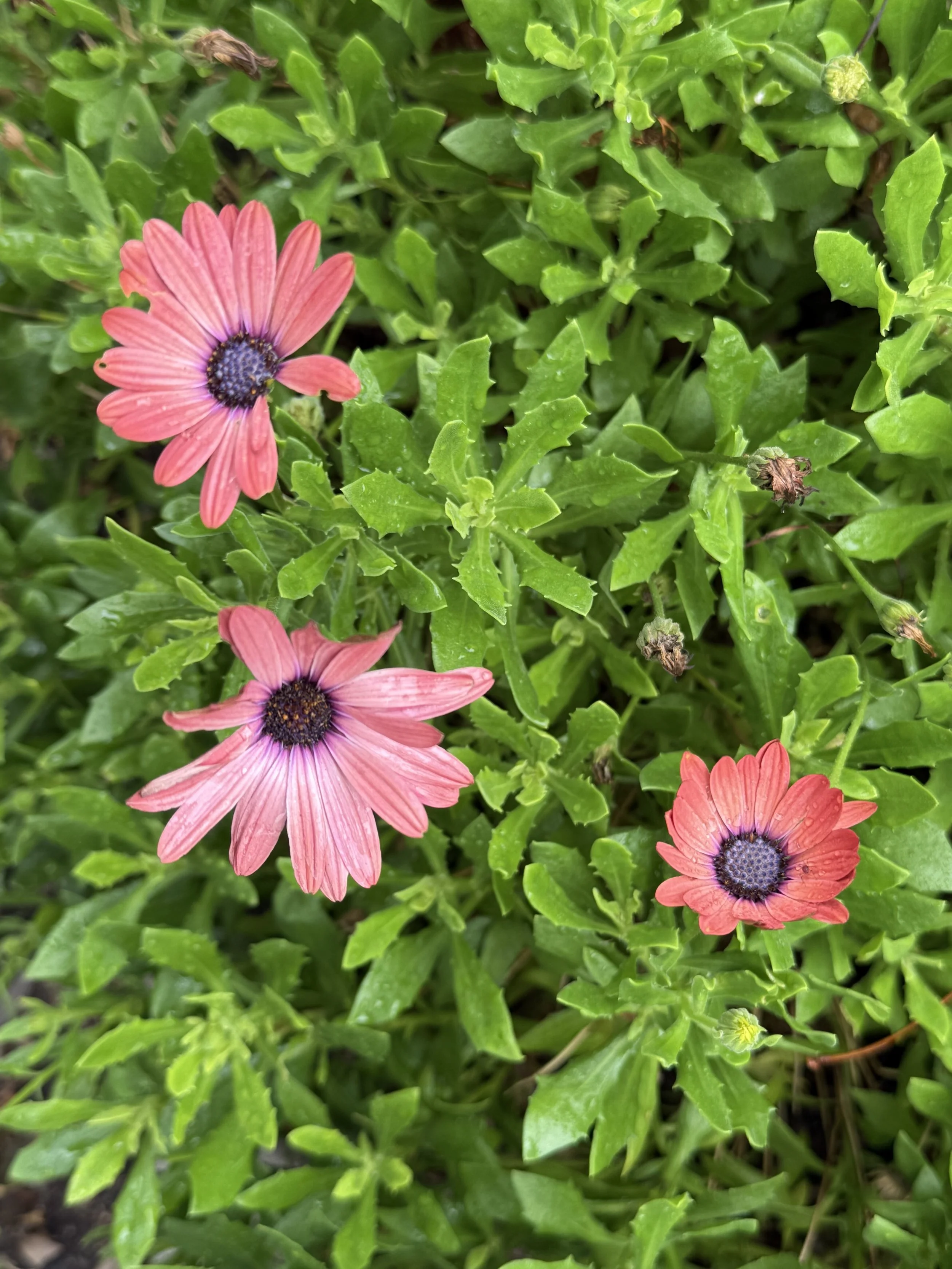
African Daisy (Osteospermum ecklonis)
Of all the African daisies we’ve planted, this variety is our favorite. The coral-toned petals and deep purple centers bring just the right pop of color without overpowering the garden. They bloom best in full sun, take short breaks during heat waves, and bounce back quickly when conditions are right. Hardy, low-maintenance, and quietly showy—just how we like them.
Ideal Zones: 9–11
Sun: Full sun (tolerates part shade in hotter spots)
Water: Low to moderate; prefers well-draining soil
-

Impatiens – New Guinea & Walleriana
This mix of New Guinea and Walleriana impatiens adds both boldness and softness to a shady corner of our yard. The New Guinea variety shines with vivid magenta flowers and deep green leaves, while the Walleriana type brings a gentler touch with lavender-pink blooms and a lighter leaf texture. Together, they make a surprisingly resilient duo—even in Zone 10 heat, with a little afternoon shade and regular water.
Ideal Zones: 10–11 (annual in cooler zones)
Sun: Morning sun or bright shade
Water: Moderate; keep evenly moist
-

French Lavender (Lavandula dentata)
With soft, toothed leaves and delicate purple blooms, French lavender brings a dreamy, aromatic calm to this sunny corner of the garden. It’s less fussy than its English cousin and thrives in heat, making it a perfect fit for our Zone 10 planter boxes.
We love how the textured foliage and long-lasting blooms invite bees and butterflies, even when the flower spikes start to fade. Just a quick trim keeps it looking fresh and full.
Ideal Zones: Perennial in Zones 8–11
Sun: Full sun
Water: Low once established; prefers well-draining soil
-
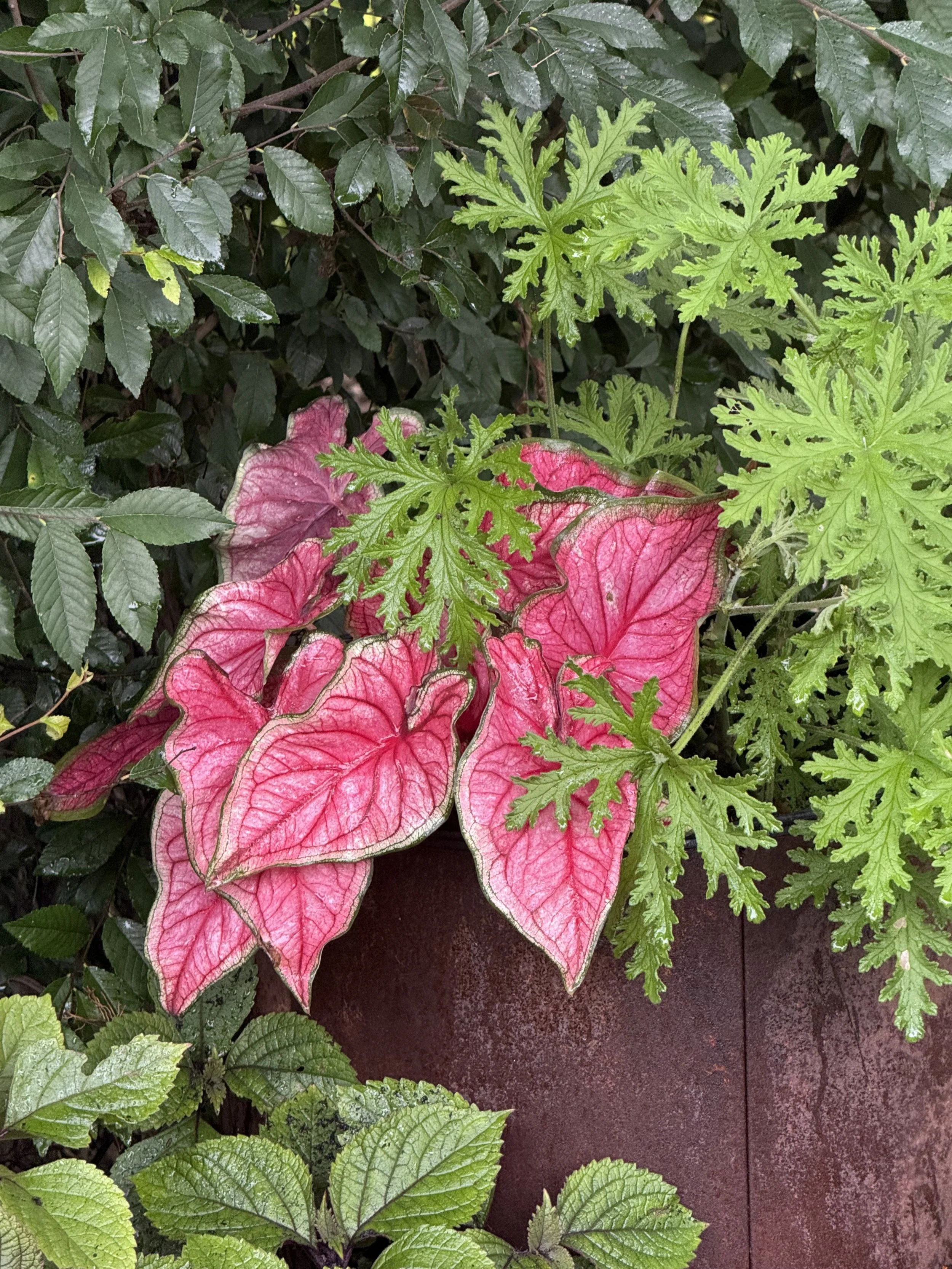
Caladium (Caladium bicolor)
These bold, heart-shaped leaves look hand-painted in hot pink with crisp white edges—an eye-catcher even in the shadiest corners. I actually got this caladium as a single potted plant from a garden center, unsure if it would survive in our heat. It’s been thriving in this partially shaded container alongside citronella geranium, and together they bring both texture and surprise to the space.
Ideal Zones: 9–11 (grow as annual or overwinter tubers in cooler zones)
Sun: Part shade to shade
Water: Moderate; keep soil evenly moist
-
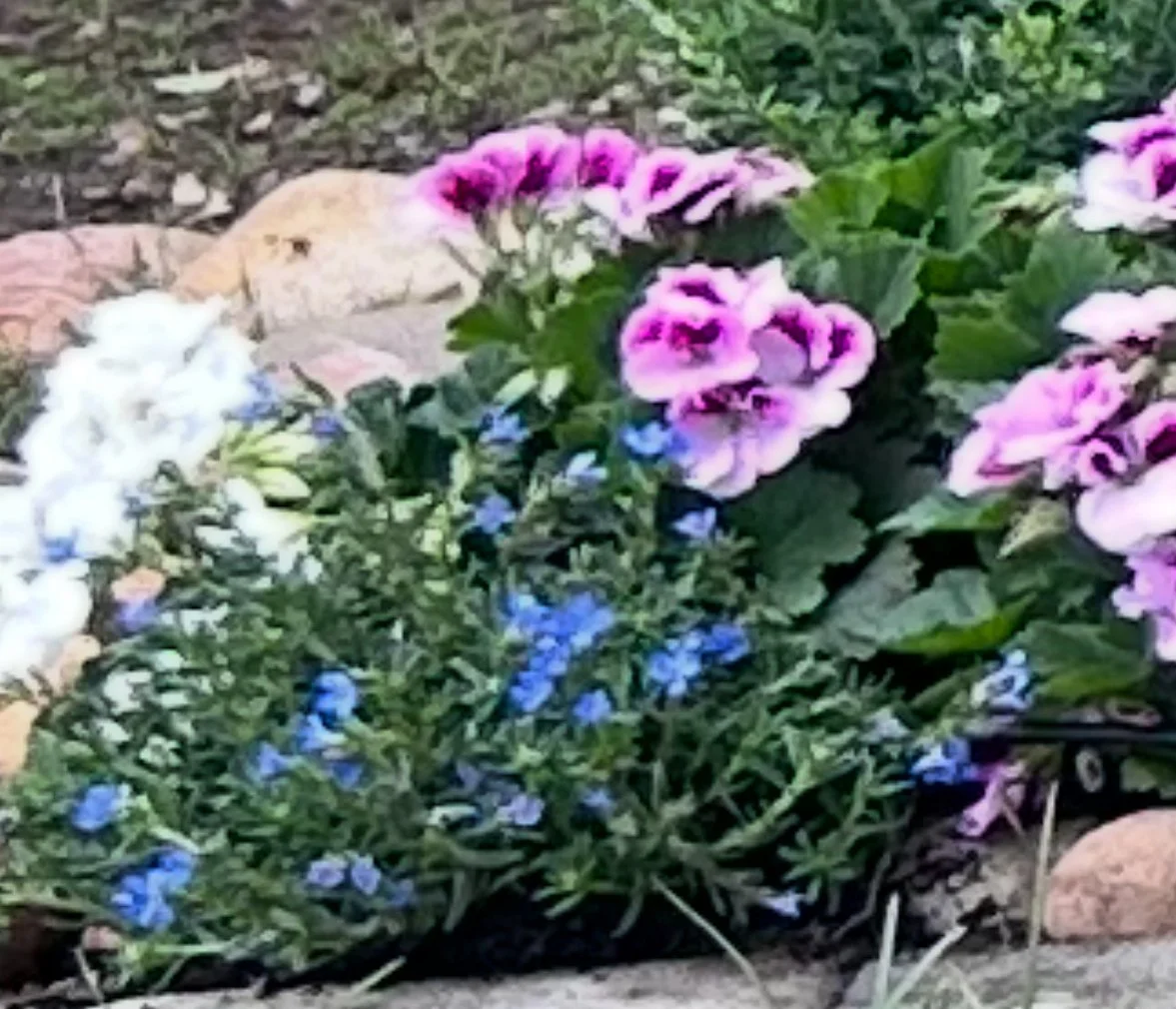
Blue Plant (Left): Lobelia (Lobelia erinus)
We weren’t totally sure how this one would handle the heat, but it’s proving tougher than expected. While it’s not blooming much right now and is getting a bit overshadowed by nearby plants, it’s still holding on thanks to steady irrigation. Lobelia does best in cooler weather and partial sun, where it can trail and bloom freely in vibrant shades of blue.
Ideal Zones: 9–11 (as a cool-season annual)
Sun: Morning sun or part shade
Water: Moderate; appreciates consistent moisture
-

Sea Lavender (Limonium perezii)
All over San Diego—from freeway slopes to sunny front yards—you’ll see these hardy purple blooms standing tall. Sea Lavender thrives on neglect: it loves heat, poor soil, and dry conditions, making it a favorite in both wild and well-tended spaces. The papery blooms last forever, both on the plant and in dried arrangements, and we love how it softens the edges of our garden with barely any care.
Ideal Zones: 9–11
Sun: Full sun
Water: Low; thrives in dry, well-draining soil
-

African Daisy (Osteospermum ecklonis – Rose Variety)
This soft pink-lavender variety has a more classic daisy shape and a slightly looser habit than some of our other Osteospermums. It’s not quite as bold as our coral favorites, but it brings a calm, meadowy vibe to the garden that we love just as much. It holds up surprisingly well in Zone 10, blooming in waves when it’s not too hot, and asking for very little in return.
Ideal Zones: 9–11
Sun: Full sun (part shade in extreme heat
Water: Low to moderate; prefers well-drained soil
-

Black-eyed Susan Vine (Thunbergia alata)
This cheerful climber brings a splash of color and charm to any garden wall or trellis. Known for its soft, velvety leaves and vibrant blooms with dark centers, the pink variety adds a sweet twist on the classic orange or yellow look. Ours quickly filled in this space, weaving through the fencing with ease and attracting plenty of pollinators along the way.
We keep this patch mostly covered, since the local rabbits seem to love snacking on it as much as we love growing it
Ideal Zones: Perennial in Zones 10–11 (grown as an annual elsewhere)
Sun: Full sun to part shade
Water: Keep soil evenly moist
-

Mexican Heather (Cuphea hyssopifolia)
Delicate-looking but tough as nails, this bushy beauty blooms nonstop with tiny purple flowers and soft green foliage. Often sold at nurseries as “Sweet Pea Bush,” it’s not a true sweet pea—but it brings the same cheerful color and compact growth habit with way less fuss.
It’s a pollinator favorite and a great “fill-in-the-gaps” plant—spilling gently over pots or borders without demanding much attention. We keep ours on the deck, where it’s happily thriving with minimal care.
Ideal Zones: Perennial in Zones 9–11
Sun: Full sun to part shade
Water: Moderate; drought-tolerant once established
-

Hosta ‘Patriot’ (Hosta spp.)
With wide, rippled green leaves edged in bright white, ‘Patriot’ brings structure and calm to a shady garden corner. Even in our Zone 10 heat, it’s holding strong with some irrigation and morning sun. Right now, it’s sending up tall purple flower spikes that hover delicately above the foliage, adding a soft, vertical contrast to the surrounding bed. It’s a cool-weather plant that’s learning to make itself at home in a warm-weather yard.
Ideal Zones: 3–9 (grows in Zone 10 with care)
Sun: Shade to part sun (best with afternoon protection)
Water: Moderate; prefers consistently moist, well-drained soil
-

Society Garlic (Tulbaghia violacea)
Tough, tidy, and surprisingly fragrant, Society Garlic adds soft purple blooms and strappy green leaves to sunny spots around the yard. Despite the name, it’s not as pungent as real garlic—though the leaves and flowers do have a mild garlicky scent (especially when brushed against).
We love it for how drought-tolerant and low-maintenance it is. It blooms reliably through warm seasons and handles poor soil and heat like a champ—plus, the bees seem to appreciate the flowers as much as we do.
Ideal Zone: Perennial in Zones 7–10
Sun: Full sun to light shade
Water: Low once established